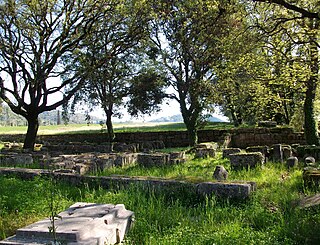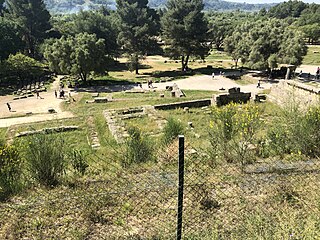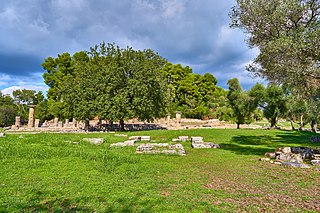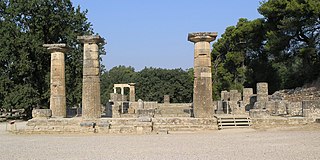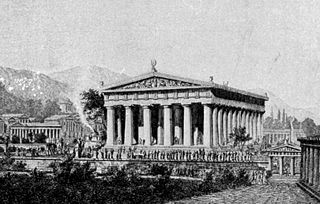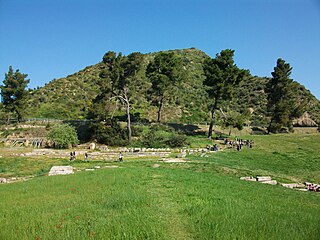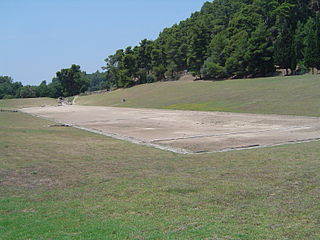Self-guided Sightseeing Tour #1 in Ancient Olympia, Greece
Legend
Guided Free Walking Tours
Book free guided walking tours in Ancient Olympia.
Guided Sightseeing Tours
Book guided sightseeing tours and activities in Ancient Olympia.
Tour Facts
2.3 km
76 m
Experience Ancient Olympia in Greece in a whole new way with our free self-guided sightseeing tour. This site not only offers you practical information and insider tips, but also a rich variety of activities and sights you shouldn't miss. Whether you love art and culture, want to explore historical sites or simply want to experience the vibrant atmosphere of a lively city - you'll find everything you need for your personal adventure here.
Individual Sights in Ancient OlympiaSight 1: Olympia
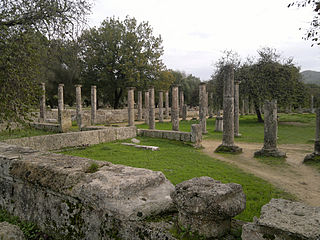
Olympia, officially Archaia Olympia, is a small town in Elis on the Peloponnese peninsula in Greece, famous for the nearby archaeological site of the same name. The site was a major Panhellenic religious sanctuary of ancient Greece, where the ancient Olympic Games were held every four years throughout Classical antiquity, from the 8th century BC to the 4th century AD. They were restored on a global basis in 1894 in honor of the ideal of peaceful international contention for excellence.
Sight 2: Echo Stoa
The Echo Stoa is located within the sanctuary of Zeus in Olympia, Greece. It is part of an ancient archaeological site excavated and preserved by the German Archaeological Institute at Athens. A stoa is a covered walkway or portico, typically colonnaded and open to the public. In ancient Greece, a stoa could be used for a variety of reasons including the selling and display of goods, and religious or public meetings. Aside from Delphi, this sanctuary was the most important one in Greece.
Sight 3: Θησαυρός Ζ
The Cybarian Treasury, also known as Treasury V in the study, was an ancient treasury in Olympia, Greece. It gets its name from the fact that it is thought to have been built by the city of Sybar, but the identification is not entirely certain. The ruins of the treasury are located in the municipality of Archaía Olympía in the archaeological site of Olympia, a UNESCO World Heritage Site.
Sight 4: Θησαυρός Κ
The Selinus Treasury, also known as Treasury IX in the study, was an ancient treasury in Olympia, Greece. It was built by the Sicilian city of Selinus. The ruins of the treasury are located in the municipality of Archaía Olympía in the archaeological site of Olympia, a UNESCO World Heritage Site.
Sight 5: Θησαυρός Λ
The treasury of the Metapontionians, also known in the study as Treasury X, was an ancient treasury in Olympia, Greece. It was built by the city of Metapontion. The ruins of the treasury are located in the municipality of Archaía Olympía in the archaeological site of Olympia, a UNESCO World Heritage Site.
Sight 6: Pelopion
The Pelopion was a structure at the ancient site of Olympia, Greece. It was the alleged tomb of Pelops, a figure in Greek mythology. It was a monument surrounded by a pentagonal structure. The tomb became an altar for animal sacrifices in Archaic Greece and continued to serve as an altar into the Roman era, until it fell into disuse with the advent of Christianity. It consisted of a mound of ashes and compacted earth, at the peak of which the sacrifice would take place – a black ram was sacrificed here every year in honor of Pelops. In order to get to the top of the altar, priests would carve steps into the mound. This packed earth form of altar was a particularly ancient one, quite unlike the more modern stone altars such as those evidenced at Delphi and the Acropolis of Athens.
Sight 7: Temple of Hera
The Temple of Hera, or Heraion, is an ancient Archaic Greek temple at Olympia, Greece, that was dedicated to Hera, queen of the Greek gods. It was the oldest temple at Olympia and one of the most venerable in all Greece. It was originally a joint temple of Hera and Zeus, chief of the gods, until a separate temple was built for him. It is at the altar of this temple, which is oriented east-west, that the Olympic flame is lit and carried to all parts of the world. The torch of the Olympic flame is lit in its ruins to this day. The temple was built in ca. 580 BC, but was destroyed by an earthquake in the early 4th century AD.
Sight 8: Temple of Zeus
The Temple of Zeus at Olympia was an ancient Greek temple in Olympia, Greece, dedicated to the god Zeus. The temple, built in the second quarter of the fifth century BC, was the very model of the fully developed classical Greek temple of the Doric order.
Sight 9: Cronious hill
Kronios hill is a small hill in Ilia which has been widely known since antiquity, as it is located next to ancient Olympia.
Sight 10: Hippodrome
The Hippodrome of Olympia housed the equestrian contests of the Ancient Olympic Games. According to Pausanias, it was situated to the south of the Stadium and covered a large area four stadia long and one stade four plethora wide. The hippodrome was a wide, flat, open space where the starting point and the finish line were designated with a pole and a second smaller pole called nyssa designated the turning point.
Sight 11: Stadium
The stadium at the archaeological site of Olympia in Greece is located to the east of the sanctuary of Zeus, outside the sacred precinct of Altis. It was the venue for many of the sporting events of the Olympic Games, as well as the Heraion women's games.
Share
How likely are you to recommend us?
Disclaimer Please be aware of your surroundings and do not enter private property. We are not liable for any damages that occur during the tours.
GPX-Download For navigation apps and GPS devices you can download the tour as a GPX file.
